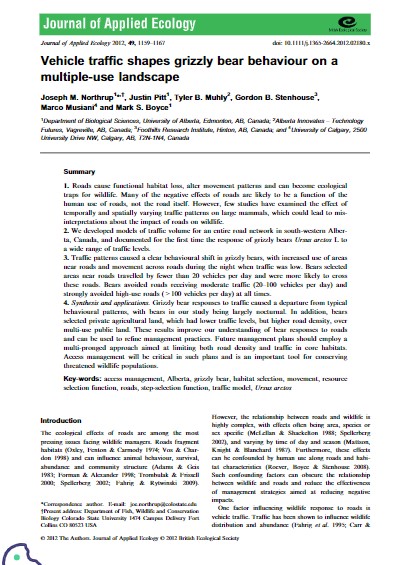Vehicle traffic shapes grizzly bear behaviour on a multiple-use landscape
Bosque Modelo:
Foothills
Temática:
Conservación
Tipo de documento:
Artículo científico
Resumen
1.Roads cause functional habitat loss, alter movement patterns and can become ecologicaltraps for wildlife. Many of the negative effects of roads are likely to be a function of thehuman use of roads, not the road itself. However, few studies have examined the effect oftemporally and spatially varying traffic patterns on large mammals, which could lead to mis-interpretations about the impact of roads on wildlife.2.We developed models of traffic volume for an entire road network in south-western Alber-ta, Canada, and documented for the first time the response of grizzly bearsUrsus arctosLtoa wide range of traffic levels.3.Traffic patterns caused a clear behavioural shift in grizzly bears, with increased use of areasnear roads and movement across roads during the night when traffic was low. Bears selectedareas near roads travelled by fewer than 20 vehicles per day and were more likely to crossthese roads. Bears avoided roads receiving moderate traffic (20–100 vehicles per day) andstrongly avoided high-use roads (>100 vehicles per day) at all times.4.Synthesis and applications.Grizzly bear responses to traffic caused a departure from typicalbehavioural patterns, with bears in our study being largely nocturnal. In addition, bearsselected private agricultural land, which had lower traffic levels, but higher road density, overmulti-use public land. These results improve our understanding of bear responses to roadsand can be used to refine management practices. Future management plans should employ amulti-pronged approach aimed at limiting both road density and traffic in core habitats.Access management will be critical in such plans and is an important tool for conservingthreatened wildlife populations.
Información Bibliográfica
Autor:
Northrup, J.M., Pitt, J., Muhly, T.B., Stenhouse, G.B., Musiani, M., & Boyce, M.S.
Revista:
Hournal of Applied Ecology
Año:
2012
N°:
-
País :
Canadá
Páginas:
1159 - 1167
Volumen:
49
Idioma:
Ingles
Palabras claves
access management, Alberta, grizzly bear, habitat selection, movement, resourceselection function, roads, step-selection function, traffic model,Ursus arctos





